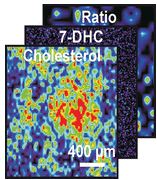 Libin Xu, Michal Kliman, Jay G. Forsythe, Zeljka Korade, Anthony B. Hmelo, Ned A. Porter and John A. McLean.
Libin Xu, Michal Kliman, Jay G. Forsythe, Zeljka Korade, Anthony B. Hmelo, Ned A. Porter and John A. McLean.
J Am Soc Mass Spectrom. 2015 Jun;26(6):924-33. Epub 2015 Mar 31.
Profiling and imaging of cholesterol and its precursors by mass spectrometry (MS) are important in a number of cholesterol biosynthesis disorders, such as in Smith-Lemli-Opitz syndrome (SLOS), where 7-dehydrocholesterol (7-DHC) is accumulated in affected individuals. SLOS is caused by defects in the enzyme that reduces 7-DHC to cholesterol. However, analysis of sterols is challenging because these hydrophobic olefins are difficult to ionize for MS detection. We report here sputtered silver matrix-assisted laser desorption/ionization (MALDI)-ion mobility-MS (IM-MS) analysis of cholesterol and 7-DHC. In comparison with liquid-based AgNO3 and colloidal Ag nanoparticle (AgNP), sputtered silver NP (10-25 nm) provided the lowest limits-of-detection based on the silver coordinated [cholesterol + Ag](+) and [7-DHC + Ag](+) signals while minimizing dehydrogenation products ([M + Ag-2H](+)). When analyzing human fibroblasts that were directly grown on poly-L-lysine-coated ITO glass plates with this technique, in situ, the 7-DHC/cholesterol ratios for both control and SLOS human fibroblasts are readily obtained. The m/z of 491 (specific for [7-DHC + (107)Ag](+)) and 495 (specific for [cholesterol + (109)Ag](+)) were subsequently imaged using MALDI-IM-MS. MS images were co-registered with optical images of the cells for metabolic ratio determination. From these comparisons, ratios of 7-DHC/cholesterol for SLOS human fibroblasts are distinctly higher than in control human fibroblasts. Thus, this strategy demonstrates the utility for diagnosing/assaying the severity of cholesterol biosynthesis disorders in vitro.


No responses yet